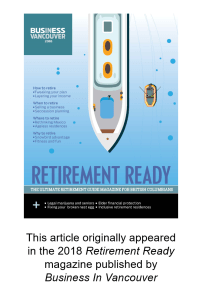“The sky is falling!” “The sky is falling!” You know the story—Chicken Little gets hit on the head by an acorn, hemistakenly believes that the sky is falling, and then he runs around hysterically warning others of an impending disaster that never happens. Likewise, for the last decade or more you may have also read media reports warning of the imminent mass exodus of the baby boomers from the Canadian workforce. But disaster has not yet struck.
The fact, however, is that disaster is looming—it has just been delayed. The great recession convinced many would-be retirees to put off retirement for another five or so years, but it has only delayed the inevitable.
Tsunami on the Horizon
The graph below shows what Canada’s age distribution looked like in 2002. Notice the bulge in the 35 – 50 age category? That’s the baby boomers. Back in 2002, the baby boomers were miles away from retiring.
Source: Analysis of data from Statistics Canada
Today, the picture is quite different. The red line represents Canada’s age distribution in 2017. You can see how the bulge has shifted to the 50 – 65 age category. That’s how old most baby boomers are today. Over on the far right side of the graph is a wall labeled “Average Age of Retirement.” This is when most Canadians expect to retire.
Source: Analysis of data from Statistics Canada
When you merge the 2002 demographics on the same graph with the 2017 demographics, the new graph shows a wave moving from left to right, crashing up against the wall of retirement, as shown below.
Source: Analysis of data from Statistics Canada
You can see that the red line is already pushing through the average age of retirement—like a tsunami that is beginning to swell over the harbour walls. Perhaps the most dangerous characteristic of a tsunami is that it doesn’t come all at once like a single wave crashing on a beach. Tsunamis appear somewhat innocuous at first, with little indication of the massive disaster soon to follow.
The grey tsunami currently hitting the Canadian labour market may seem like a moderate swell of retirements now, but make no mistake, this is just the beginning.
You Can Do Something About It!
Like Chicken Little, some companies think there is nothing they can do about the tsunami of retiring baby boomers, and that the tsunami will affect all companies equally—but neither perspective is true.
Companies can insulate themselves from the effects of the retiring baby boomers by establishing an effective succession plan and actively developing their future leaders. Those companies that don’t develop a plan to deal with the increase in retirements will be fighting the war for talent for the next fifteen years against the other organizations that also failed to plan.
A minority of companies are preparing and implementing succession plans for the time when the recruiting well will eventually run dry. The rest of the corporate world should take a few notes from the playbooks of these proactive firms.
[bctt tweet=”Companies can insulate themselves from the effects of the retiring baby boomers by establishing an effective succession plan and actively developing their future leaders.” username=”availleadership”]
The Best Five Things You Can Do Now To Prepare
- Make leadership & talent development a top strategic priority. The only organizations that can sustain leadership and talent development (aka “succession planning”) are the ones that view it as one of their top strategic priorities. Until they do, people development work will always be at the mercy of the urgent crises of the day, and it simply won’t get done.
- Start with simple leadership competencies. Before you can craft a plan to develop future leaders, everyone needs to be very clear on the answer to this question: “What does it take to be successful here?” The answer lies not in a complex competency model, but in a simple set of criteria that everyone understands and regularly refers to. The best companies use these criteria every time they make a people-related decision such as who to hire, who to promote, and what areas they need to develop.
- Stop the vicious cycle of recruiting. When companies continue to hire external people into leadership positions, they are sending a clear message to their ambitious junior staff that they must go somewhere else to advance their career – and they will. The next time these companies have a leadership vacancy, they won’t have anyone to promote, so they’ll be forced to recruit externally, and the cycle will continue.
- Stop promoting primarily based on technical ability. Promoting people to their level of incompetence destroys morale and exacerbates the brain drain. Bright young stars will not stick around long under a boss with no leadership ability. Research shows that the best leaders were generally not the best individual performers. The most effective leaders are the ones that bring out the best in others. (Hint: this should come through loud and clear in your leadership competencies!)
- Pair younger stars with seasoned veterans. Begin now to identify employees with leadership potential and craft a formal development plan for them that includes learning specific competencies from the company’s best employees.
Build the Ark Before The Rain
In the movie Spy Game, Robert Redford’s character asks his secretary “When did Noah build the ark, Gladys?” He then answers his own question: “Before the rain.”
I often hear about company owners who, planning to retire in the next two years, are prompted to begin to seriously think about succession planning. Bad news… from the time you begin to implement a leadership and talent development program, it takes at least two years before you begin seeing any real benefits. It takes about three to four years to build a strong internal pipeline of leadership and top talent. There is no time to waste.
[bctt tweet=”Don’t wait for a talent crisis before making leadership and talent development a top strategic priority.” username=”availleadership”]
The impending grey tsunami and owner retirements aren’t the only reasons companies should begin preparing now. Those are simply some of the things we can forecast. Other harder-to-predict challenges include senior leaders whose health suddenly fails, or who unexpectedly leave for other reasons. The key is this: don’t wait for a talent crisis before making leadership and talent development a top strategic priority.
______________________________________________________________________________________
To discover what it takes to build a world-class leadership and talent development program, take Avail Leadership’s FREE Talent Development Assessment.










